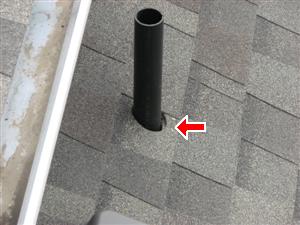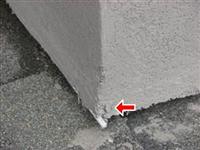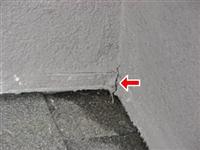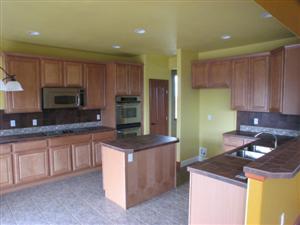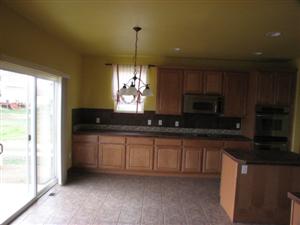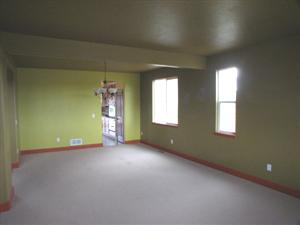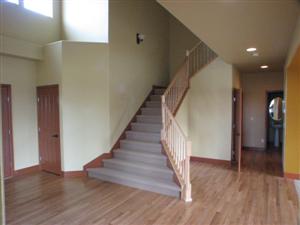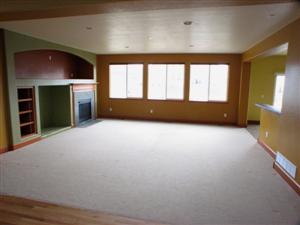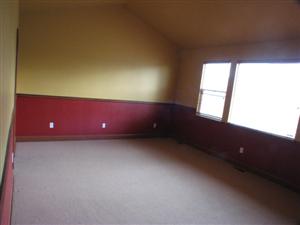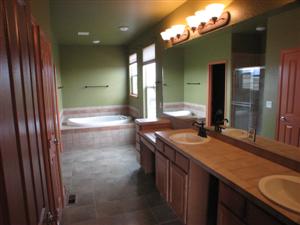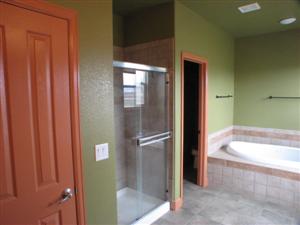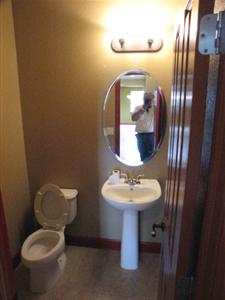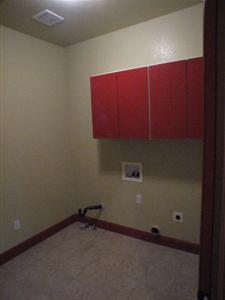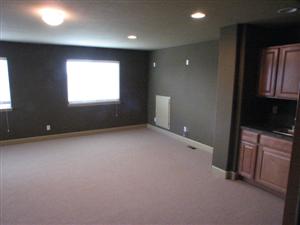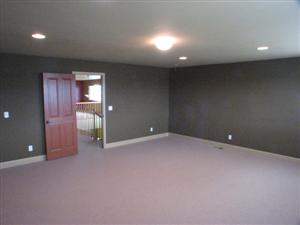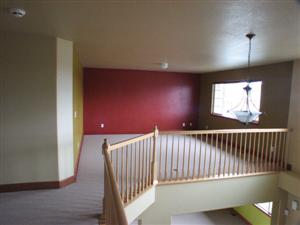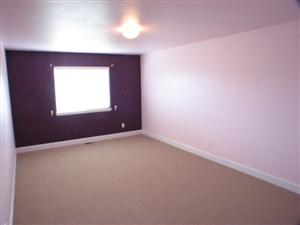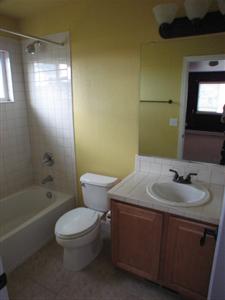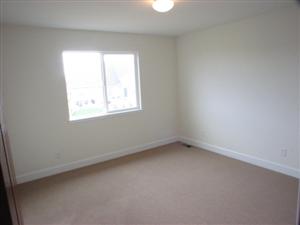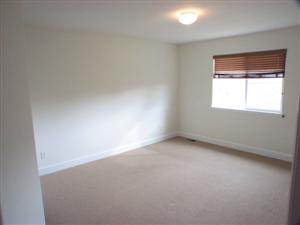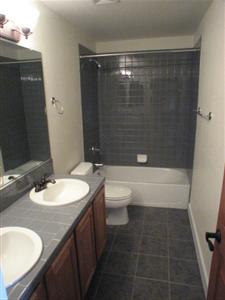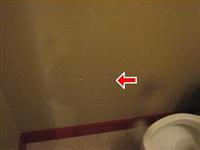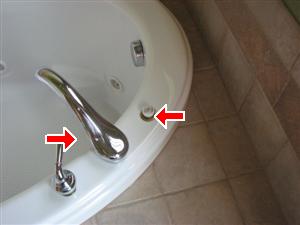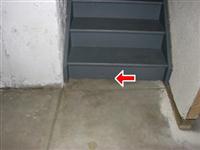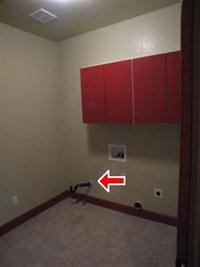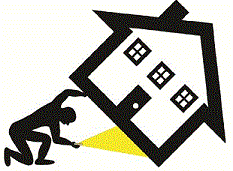The home inspector shall observe: Roof covering; Roof drainage systems; Flashings; Skylights, chimneys, and roof penetrations; and Signs of'
leaks or abnormal condensation on building components. The home inspector shall: Describe the type of roof covering materials; and Report
the methods used to observe the roofing. The home inspector is not required to: Walk on the roofing; or Observe attached accessories
including but not limited to solar systems, antennae, and lightning arrestors.
IN=Inspected, NI=Not Inspected, NP=Not Present, MR=Maintenance Repair or Replace, SI=Safety Item, AC=Area of Concern
| Styles & Materials
WALKED ROOF
SCULPTERED FIBERGLASS
HIP
RIDGE VENTS
SOFFIT VENTS
METAL FLUE PIPE
NONE
|
The home inspector shall observe: Wall cladding, flashings, and trim; Entryway doors and a representative number of windows; Garage door
operators; Decks, balconies, stoops, steps, areaways, porches and applicable railings; Eaves, soffits, and fascias; and Vegetation, grading,
drainage, driveways, patios, walkways, and retaining walls with respect to their effect on the condition of the building. The home inspector
shall: Describe wall cladding materials; Operate all entryway doors and a representative number of windows; Operate garage doors manually or
by using permanently installed controls for any garage door operator; Report whether or not any garage door operator will automatically reverse
or stop when meeting reasonable resistance during closing; and Probe exterior wood components where deterioration is suspected. The home
inspector is not required to observe: Storm windows, storm doors, screening, shutters, awnings, and similar seasonal accessories; Fences;
Presence of safety glazing in doors and windows; Garage door operator remote control transmitters; Geological conditions; Soil conditions;
Recreational facilities (including spas, saunas, steam baths, swimming pools, tennis courts, playground equipment, and other exercise,
entertainment, or athletic facilities); Detached buildings or structures; or Presence or condition of buried fuel storage tanks. The home
inspector is not required to: Move personal items, panels, furniture, equipment, plant life, soil, snow, ice or debris that obstructs access or
visibility.
IN=Inspected, NI=Not Inspected, NP=Not Present, MR=Maintenance Repair or Replace, SI=Safety Item, AC=Area of Concern
| Styles & Materials
EIFS
LAP
COMPOSITE BOARD
EIFS
COVERED PORCH
STEEL
CONCRETE
|
IN=Inspected, NI=Not Inspected, NP=Not Present, MR=Maintenance Repair or Replace, SI=Safety Item, AC=Area of Concern
| Styles & Materials
GENIE
INSULATED
METAL
ONE MANUAL
ONE AUTOMATIC
|
IN=Inspected, NI=Not Inspected, NP=Not Present, MR=Maintenance Repair or Replace, SI=Safety Item, AC=Area of Concern
| |
IN=Inspected, NI=Not Inspected, NP=Not Present, MR=Maintenance Repair or Replace, SI=Safety Item, AC=Area of Concern
| Styles & Materials
WOOD
TILE
37 1/2 INCHES
39 1/2 INCHES
72 1/4 INCHES
GENERAL ELECTRIC
IN SINK ERATOR
GENERAL ELECTRIC
GENERAL ELECTRIC
NONE
|
IN=Inspected, NI=Not Inspected, NP=Not Present, MR=Maintenance Repair or Replace, SI=Safety Item, AC=Area of Concern
| Styles & Materials
FAN ONLY
|
The home inspector shall observe: Walls, ceiling, and floors; Steps, stairways, balconies, and railings; Counters and a representative number of
installed cabinets; and A representative number of doors and windows. The home inspector shall: Operate a representative number of windows
and interior doors; and Report signs of abnormal or harmful water penetration into the building or signs of abnormal or harmful condensation on
building components. The home inspector is not required to observe: Paint, wallpaper, and other finish treatments on the interior walls, ceilings,
and floors; Carpeting; or Draperies, blinds, or other window treatments.
IN=Inspected, NI=Not Inspected, NP=Not Present, MR=Maintenance Repair or Replace, SI=Safety Item, AC=Area of Concern
| Styles & Materials
SHEETROCK
SHEETROCK
CARPET
HARDWOOD T&G
TILE
RAISED PANEL
THERMAL/INSULATED
|
IN=Inspected, NI=Not Inspected, NP=Not Present, MR=Maintenance Repair or Replace, SI=Safety Item, AC=Area of Concern
| Styles & Materials
BLOWN
BATT
R-30 OR BETTER
2X4 RAFTERS
2 X 6 RAFTERS
2X4
FROM ENTRY
SCUTTLE HOLE
|
The home inspector shall observe: Service entrance conductors; Service equipment, grounding equipment, main over current device, and main
and distribution panels; Amperage and voltage ratings of the service; Branch circuit conductors, their over current devices, and the compatibility
of their ampacities and voltages; The operation of a representative number of installed ceiling fans, lighting fixtures, switches and receptacles
located inside the house, garage, and on the dwelling's exterior walls; The polarity and grounding of all receptacles within six feet of interior
plumbing fixtures, and all receptacles in the garage or carport, and on the exterior of inspected structures; The operation of ground fault circuit
interrupters; and Smoke detectors. The home inspector shall describe: Service amperage and voltage; Service entry conductor materials;
Service type as being overhead or underground; and Location of main and distribution panels. The home inspector shall report any observed
aluminum branch circuit wiring. The home inspector shall report on presence or absence of smoke detectors, and operate their test function, if
accessible, except when detectors are part of a central system. The home inspector is not required to: Insert any tool, probe, or testing device
inside the panels; Test or operate any over current device except ground fault circuit interrupters; Dismantle any electrical device or control
other than to remove the covers of the main and auxiliary distribution panels; or Observe: Low voltage systems; Security system devices, heat
detectors, or carbon monoxide detectors; Telephone, security, cable TV, intercoms, or other ancillary wiring that is not a part of the primary
electrical distribution system; or Built-in vacuum equipment.
IN=Inspected, NI=Not Inspected, NP=Not Present, MR=Maintenance Repair or Replace, SI=Safety Item, AC=Area of Concern
| Styles & Materials
BELOW GROUND
200 AMP
CIRCUIT BREAKERS
GENERAL ELECTRIC
COPPER
ROMEX
|
The Home Inspector shall observe structural components including foundations, floors, walls, columns or piers, ceilings and roof. The home
inspector shall describe the type of Foundation, floor structure, wall structure, columns or piers, ceiling structure, roof structure. The home
inspector shall: Probe structural components where deterioration is suspected; Enter under floor crawl spaces, basements, and attic spaces
except when access is obstructed, when entry could damage the property, or when dangerous or adverse situations are suspected; Report the
methods used to observe under floor crawl spaces and attics; and Report signs of abnormal or harmful water penetration into the building or
signs of abnormal or harmful condensation on building components. The home inspector is not required to: Enter any area or perform any
procedure that may damage the property or its components or be dangerous to or adversely effect the health of the home inspector or other
persons.
IN=Inspected, NI=Not Inspected, NP=Not Present, MR=Maintenance Repair or Replace, SI=Safety Item, AC=Area of Concern
| Styles & Materials
POURED CONCRETE
ENGINERED FLOOR TRUSS
2 X 4 WOOD
STEEL LALLY COLUMNS
STEEL SCREW JACKS
|
The home inspector shall observe: Interior water supply and distribution system, including: piping materials, supports, and insulation; fixtures
and faucets; functional flow; leaks; and cross connections; Interior drain, waste, and vent system, including: traps; drain, waste, and vent
piping; piping supports and pipe insulation; leaks; and functional drainage; Hot water systems including: water heating equipment; normal
operating controls; automatic safety controls; and chimneys, flues, and vents; Fuel storage and distribution systems including: interior fuel
storage equipment, supply piping, venting, and supports; leaks; and Sump pumps. The home inspector shall describe: Water supply and
distribution piping materials; Drain, waste, and vent piping materials; Water heating equipment; and Location of main water supply shutoff
device. The home inspector shall operate all plumbing fixtures, including their faucets and all exterior faucets attached to the house, except
where the flow end of the faucet is connected to an appliance. The home inspector is not required to: State the effectiveness of anti-siphon
devices; Determine whether water supply and waste disposal systems are public or private; Operate automatic safety controls; Operate any
valve except water closet flush valves, fixture faucets, and hose faucets; Observe: Water conditioning systems; Fire and lawn sprinkler
systems; On-site water supply quantity and quality; On-site waste disposal systems; Foundation irrigation systems; Spas, except as to
functional flow and functional drainage; Swimming pools; Solar water heating equipment; or Observe the system for proper sizing, design, or
use of proper materials.
IN=Inspected, NI=Not Inspected, NP=Not Present, MR=Maintenance Repair or Replace, SI=Safety Item, AC=Area of Concern
| Styles & Materials
PUBLIC
COPPER
COPPER
2" DIAMETER
PVC
GAS (QUICK RECOVERY)
50 GAL (2-3 PEOPLE)
RHEEM
|
The home inspector shall observe permanently installed heating systems including: Heating equipment; Normal operating controls; Automatic
safety controls; Chimneys, flues, and vents, where readily visible; Solid fuel heating devices; Heat distribution systems including fans, pumps,
ducts and piping, with supports, insulation, air filters, registers, radiators, fan coil units, convectors; and the presence of an installed heat
source in each room. The home inspector shall describe: Energy source; and Heating equipment and distribution type. The home inspector
shall operate the systems using normal operating controls. The home inspector shall open readily openable access panels provided by the
manufacturer or installer for routine homeowner maintenance. The home inspector is not required to: Operate heating systems when weather
conditions or other circumstances may cause equipment damage; Operate automatic safety controls; Ignite or extinguish solid fuel fires; or
Observe: The interior of flues; Fireplace insert flue connections; Humidifiers; Electronic air filters; or The uniformity or adequacy of heat supply
to the various rooms.
IN=Inspected, NI=Not Inspected, NP=Not Present, MR=Maintenance Repair or Replace, SI=Safety Item, AC=Area of Concern
| Styles & Materials
FORCED AIR
GAS
TWO
CARRIER
NON-INSULATED
DISPOSABLE
20x25
|
The home inspector shall observe: Central air conditioning and permanently installed cooling systems including: Cooling and air handling
equipment; and Normal operating controls. Distribution systems including: Fans, pumps, ducts and piping, with associated supports, dampers,
insulation, air filters, registers, fan-coil units; and The presence of an installed cooling source in each room. The home inspector shall describe:
Energy sources; and Cooling equipment type. The home inspector shall operate the systems using normal operating controls. The home
inspector shall open readily openable access panels provided by the manufacturer or installer for routine homeowner maintenance The home
inspector is not required to: Observe window air conditioners or operate cooling systems when weather conditions or other circumstances may
cause equipment damage; Observe non-central air conditioners; or Observe the uniformity or adequacy of cool-air supply to the various rooms.
IN=Inspected, NI=Not Inspected, NP=Not Present, MR=Maintenance Repair or Replace, SI=Safety Item, AC=Area of Concern
| Styles & Materials
AIR CONDITIONER UNIT
ELECTRICITY
CARRIER
TWO
|
IN=Inspected, NI=Not Inspected, NP=Not Present, MR=Maintenance Repair or Replace, SI=Safety Item, AC=Area of Concern
| Styles & Materials
VENTED GAS LOGS
ONE
|
Y=Yes, N=No, NP=Not Present, MR=Maintenance Repair or Replace, SI=Safety Item, AC=Area of Concern
| |
Prepared Using HomeGauge http://www.HomeGauge.com : Licensed To McDowell's Home Inspections
